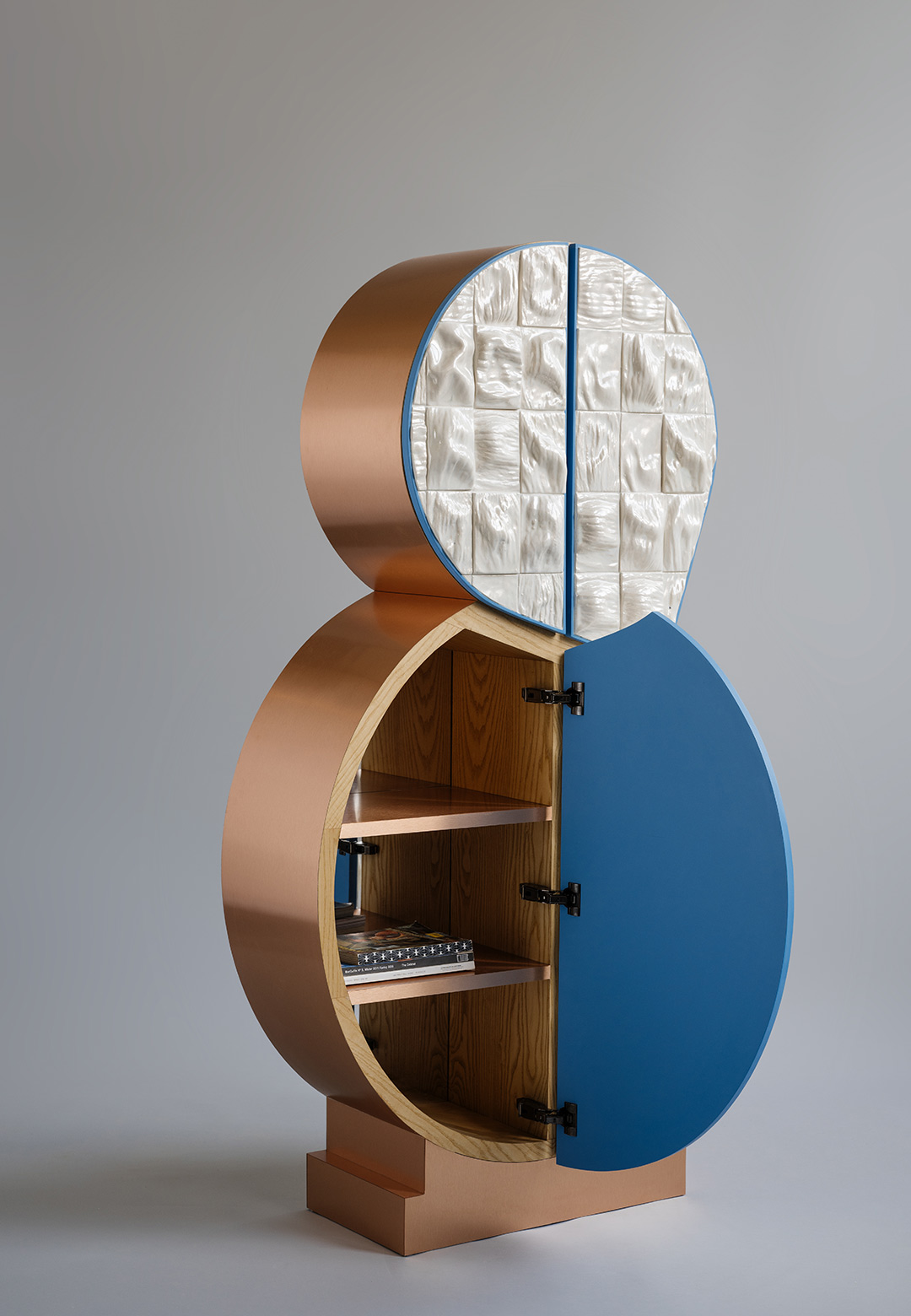A refreshing experience of materiality, an inclination towards organic forms and a knack for playful exploration define the expanding creative repertoire of REM Atelier, an art and design studio based in Rotterdam, the Netherlands. Remty Elenga and Remco van Halderen, together, helm the interdisciplinary practice that yields diverse furniture designs, objects and installations, injecting a sense of singularity and whimsy in the seemingly austere extents of functionality. The design duo questions the notions and parameters that mould objects and products of the everyday. The Dutch designers' recent interventions such as Shifting Forms (2024), a multifunctional piece of furniture comprising eight different modules that can work together or independently, and Surfaced Cabinet (2024), a functional sculpture donned in ceramic tiles, attest to this ethos.
Ceramics recurrently appears in the studio's oeuvre as both an abstraction and a medium of exploration, enveloping different forms and expressing various visual textures. In their latest projects, Elenga and van Halderen experiment with decaying melon skins to achieve detailed impressions on the ceramic surfaces. STIR speaks to the creative duo to understand the artistic sensibilities crafting REM Atelier's fascinating endeavours. The conversation also delves into the unique making processes in motion in the studio and the creative philosophies and tenets that steer its distinct product design ensembles.
Anushka Sharma: The usage of ceramic tiles is central in many of your series such as Shifting Forms and Surfaced. Is there a reason behind their recurring presence in your practice?
REM Atelier: Working with ceramics demands deep engagement with the material. It is a slow yet surprisingly versatile process, offering countless possibilities. We first turned to ceramics while searching for a way to shape our Curved Melon Totem concept and it has captivated us ever since. The sculptural and artisanal nature of ceramics continues to draw us in, inspiring our work time and time again.
Anushka: In Surfaced Cabinet, "the surface structures are casts of various decaying melon skins", yielding detailed impressions. Could you elaborate on the process and the choice of material here?
REM Atelier: When we first began working with ceramics, we created imprints of a decaying melon skin by casting actual melon fruits. We were immediately drawn to the abstraction of the organic structure, which became more than just a piece of fruit—it transformed into a surface of its own.
Since then, we have pushed our material research further—using older moulds to create new ones and reversing surfaces so that what is inside becomes the exterior and vice versa. Transforming a round melon shape into hand-cut tiles, then casting those tiles and finally reversing their moulds, we witnessed a truly transformative process. It is fascinating to see a single starting point evolve into various new forms.
Anushka: Could you elaborate on the initial idea and concept behind Shifting Forms and the process of conceiving its modular feature?
REM Atelier: The tiles now feature in our Surfaced Cabinet series, while the reversed moulds of these tiles serve as the building blocks for Shifting Forms. In this series, repurposed moulds invert the tile shapes, creating an effect that seems to pull the form into the block. By merging artisanal moulding with modern techniques such as 3D printing, we have crafted a modular system that continuously transforms and redefines itself. This endless playfulness in repurposing and reinventing is what captivates us—there is always a new shape waiting to be born from the old.
Anushka: How has your understanding of ceramic craft techniques evolved through your design journey? What are some challenges while employing the medium in your furniture and objects?
REM Atelier: Mould making, pouring and glazing are distinct crafts, each demanding its own unique approach. We started as 'ceramic cowboys', knowing little about the material and its inherent qualities and learned [the technique] entirely through hands-on experience. Along the way, we encountered moments of serendipity and minor setbacks, as ceramic can only be controlled to a certain extent. There is always an element of surprise—a process that inspires both love and frustration. When a glaze doesn't turn out as expected, perhaps due to subtle temperature variations in the kiln, we let it rest overnight. The next day, the unexpected result often reveals a new perspective. It is quite emotional actually, a lot of feeling is involved in the making.
Anushka: What other materials have you worked with or intend to explore in your modular designs?
REM Atelier: We recently started working with resin, a more synthetic material than clay. Working with resin does not yet feel entirely natural to us. The material has a cool appearance and lacks the tactile tension we experience with natural materials such as ceramic. However, casting resin gains a unique dynamic when light shines through it, creating a beautiful, often dreamlike effect. The combination of casting resin and ceramic results in a fascinating contrast and it is interesting to explore how the same forms manifest differently in both materials.
Anushka: What do your designs aim to convey? Additionally, how do they align with your creative philosophy?
REM Atelier: We want to create things that are unique, long-lasting and that have an aura of their own. No mass production, but limited pieces that are personal. Everything is handmade in our studio and by local artisans from our area in Rotterdam, the Netherlands. We want to create timeless pieces that you can love for life.
Anushka: What is NEXT for you?
REM Atelier: We have a solo exhibition coming up during the first Design Biennale ever in our hometown of Rotterdam from February 20 – March 2, 2025. Later this year we are organising a show at Design Miami with Galerie Mélissa Paul. We are also working on three new pieces to come out this year. Very exciting!






 Sign in with email
Sign in with email










What do you think?